Answers
|
|
|
|
|
Question 1
Visualize radiation measurements over time from both static and mobile sensors to identify areas where radiation over background is detected. Characterize changes over time.
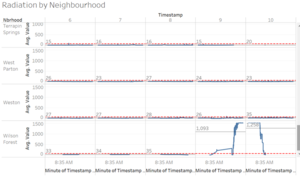
The chart above shows the average radiation of the mobile sensors (blue line) and static sensors (yellow line) by Neighbourhood. The red line is the 75cpm mark whereby any value beyond that point is abnormal.
As seen from above, from the 9th to 10th, Wilson Forest has spike in the radiation readings with an average value of 1093cpm on the 9th and 1258cpm on the 10th while the rest are under 54 and 72 on the 9th and 10th respectively.

As the readings for Wilson Forest is very high on the 9th and the 10th, I decided to uncheck Wilson Forest to further analyse the other days.
For the analysis above, sensor id M12 has been filtered out (explained in Question 2).
Even though the average reading on the 6th of April are below 75cpm, there are certain spikes in certain neighbourhoods such as Broadview, Chapparal and Palace Hills etc.
Similarly, on the 7th of April, there are also a few peaks at certain neighbourhoods such as Broadview and Chapparal whereby they exceed 75cpm.
The more extreme readings can be seen on the 8th of April in Old Town whereby the mobile sensor readings spiked to 264.4, which the readings were above 75cpm from 5:30PM to 9:30PM.
Also, in Safe Town, there was a spike to 193.2CPM, which the readings were above 75cpm 1:20PM to 4:30PM. Apart from those towns, more towns have a radiation level exceeding 75cpm at certain timings.

In this analysis, I excluded Wilson Forest as there was a contrasting difference in the readings which will be explained in part 2 later.
From the 6th to the 7th, there is not much difference in the level of the radiation level, with a maximum of 15.4% increase in the average radiation level in Terrapin Springs. From the 7th to the 8th, there is a visible increase in the radiation level in old town whereby it increased by 118.5%.
Question 2
Use visual analytics to represent and analyze uncertainty in the measurement of radiation across the city.
a. Compare uncertainty of the static sensors to the mobile sensors. What anomalies can you see? Are there sensors that are too uncertain to trust?
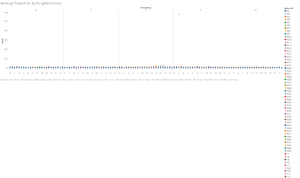
As seen above, On the 9th of April, there is an outlier sensor id that has a value of 57,345 at 02:00 belonging to M12 while the rest are below 3K. This shows sensor id M12 may not be reliable.
Most times, the mobile sensor show different patterns as compared to the static sensors whereby they fluctuate much more. One example can be seen from the Broadview. As seen from the graph, the mobile sensors and static sensors spike at different timings.
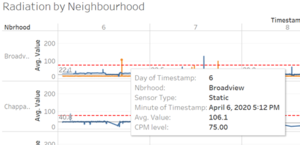
On the 6th, the static sensors showed that the average radiation readings at 5:12PM is above the normal radiation level, hitting 106.1cpm while the mobile sensor readings showed the average readings was 15.4cpm only, below the normal radiation level.
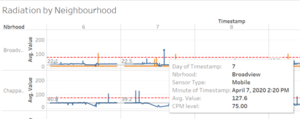
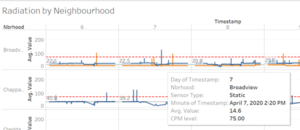
Another example can be seen on the 7th of April. The mobile sensors readings spiked at 2:20pm with a value of 127.6cpm while the static sensor reading is only 14.6cpm.
b. Which regions of the city have greater uncertainty of radiation measurement? Use visual analytics to explain your rationale.

The chart above is broken down by days, whereby the table shows the difference in value of the average radiation value of the respective day as compared to the previous day. Red represents an increase in the radiation value while green represents a drop in the radiation value. As seen above, on 9th April, Wilson Forest has an increase of 3792% as compared to the previous’ day readings while the other cities only have a maximum of 57% increase on the 9th of April, which is a drastic difference.
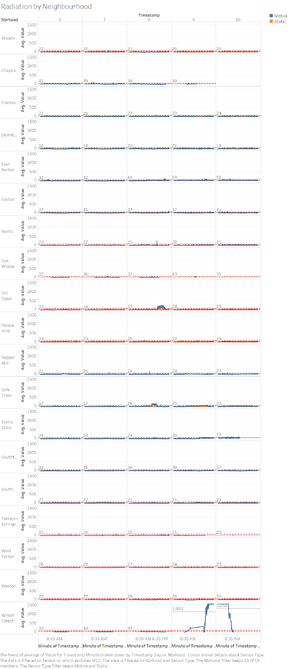
As seen from above, only Wilson Forest has a spike in radiation level whereby the radiation level peaked at 1509cpm on 9th April whereby there was a sudden spike that lasted till 10th April.
As compared to the other neighbourhoods, the average radiation level of Wilson Forest on the 9th is 1093cpm while the rest are below 54cpm and below. On the 10th, the average radiation level of Wilson Forest is 1258cpm while the rest are below 72cpm and below. This is odd as the power plant is far away from Wilson Forest. We are unable to conclude whether the readings are reliable as well as only mobile sensor readings are recorded and there were no static sensors.
c. What effects do you see in the sensor readings after the earthquake and other major events? What effect do these events have on uncertainty?

As seen above, there is a significant increase in the radiation level in most neighbourhoods. Thus, I suspect that the earthquake happened around sometime on the 8th of April.

As the nuclear plant is in Safe Town, I decided to further analyse the radiation level in Safe Town. Based on the static sensor, the radiation level spiked at 9:48AM from 13.9cpm to 55cpm. More spikes followed later during the day as well.
![]()
By looking at the mobile sensors, we can see that there the radiation level has a slight spike at 9:04AM, similar to the static sensor readings. There is a huge increase in the radiation level whereby it exceeded 75cpm at 11:44am first and continued to exceed 75cpm from 1:36PM to 4:22PM.
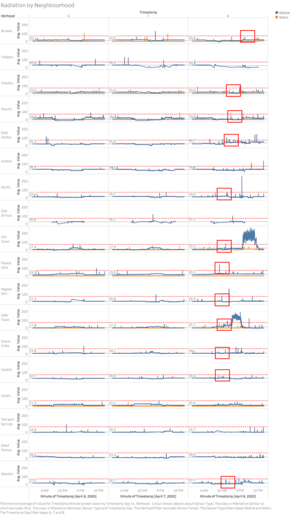
By looking at the other neighbourhoods, many of them have a spike in the radiation level on the 8th from 9AM onwards. Thus, I deduced that the earthquake happened around 9AM on the 8th of April. As highlighted in the screenshot above, there was a spike in the radiation readings in Broadview, Cheddarford, Downtown, East Parton, Northwest, Old Town, Palace Hills, Pepper Mill, Safe Town, Scenic Vista and Weston.
The radiation then started to disperse during the later part of the day. As seen from above, Northwest, Safe Town and Old Town have a spike in the radiation readings by the mobile sensors. However, by looking at the static sensor readings in Safe Town and Old Town, the static sensor readings is below 75cpm. Thus, the high radiation level readings may not be due to the exposure of radiation in that neighbourhood alone.
